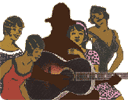The "dressed in red/white/black/blue" verses can be found in various spirituals and religious songs, such as Wade in the Water and Go Tell It On the Mountain, and I suspect that it is these songs that are the source of the "dressed in red" formula that we're now used to in blues lyrics. These floating verses are not linked to funeral or mourning practices. I'd already mentioned the verse from "I Heard the Angels Singin'":
Who is that yonder all dressed in red?
I heard the angels singin'
It look like the children Moses led
I heard the angels singin'
Here are some examples from "Songs and Rhymes from the South" - E.C. Perrow, published 1912-1915
http://www.csufresno.edu/folklore/drinkingsongs/html/books-and-manuscripts/1910s/1912-15-songs-from-the-south/part-1/index.htm(also part 2 and 3 available there)
Perrow collected similar lines in a couple other religious songs. Parenthetical notes with sources/dates etc. are his.
29. MY LORD, HE DIED ON DE CROSS
(From North Carolina; negroes; MS. of W. O. Scroggs; 1908)
Yonder come chillun dressed in white;
Look lak de chillun ob de Israelite.
Refrain
My Lord, he died on de cross.
Yonder come chillun dressed in red;
Look lak chillun what Moses led.
Yonder come chillun dressed in black;
Look lak de hypercrits turnin' back.
30. PHARAOH'S ARMY GOT DROWNDED
(From East Tennessee; negroes; from memory; 1905)
Who's dat comin', all dressed in red?
One uh dem people dat Pharaoh led.
Pharaoh's army got drownded,
O Mary! don't yuh weep.
The formula is found in both black and white music as well. From a version of John Henry also found in Perrow (From Kentucky; mountain whites; MS. of E. N. Caldwell; 1912):
John Henry had a lovin' little wife,
Sometimes she was dressed in red;
She went walkin' down the track, and she never looked back;
She said, "I'm goin' where my honey fell dead."
John Henry had a lovin' little wife,
Sometimes she was dressed in blue;
Went to the graveyard where his dead body lies;
"John Henry, I've always been true to you."
Then from OLD BRADY
(From Mississippi; country whites; MS. of R. J. Slay, student; 1908)
They sent for the doctor in a mighty haste.
" Oh, yonder comes the surgeon in a racking pace!"
He raised his hand, and his hand was red,
" Oh, my goodness gracious! old Brady is dead!"
When the news got out that old Brady was dead,
Out come the ladies all dressed in red.
John Lomax also has a version of John Henry with an "all dressed in red" verse.
John Henry - From American Ballads and Folk Songs, Lomax
John Henry's lil mother,
She was all dressed in red,
She jumped in bed, covered up her head,
Said she didn' know her son was dead,
Lawd, Lawd, didn' know her son was dead.
Then there are several verses from "John Hardy" in Cox, Folk-Songs of the South
1924, this one collected by Prof. J.H. Combs in Knott County, Kentucky
John Hardy had a pretty little wife,
She always went dressed in green;
And coming down on the hanging ground,
Says, "Johnny, you were always too mean."
John Hardy had a true little boy,
He was all dressed in black;
As coming down on the hanging ground,
Says, "Papa, I wish that you were back."
John Hardy had a true little girl,
She always dressed in red;
As coming down on the hanging ground,
Says, "Papa, I would rather be dead."
Lastly, a couple verses from "Elkhorn Ridge", which is supposedly traditional but I only have it in a great recorded version by Oscar Wright.
Yonder comes that girl of mine
She's all dressed in red
Looking down at her pretty little feet
And I wished my wife was dead
[snip]
Yonder comes that gal of mine
She's all dressed in brown
She is the darling of my heart
I'll see her for the sun goes down









 Logged
Logged



